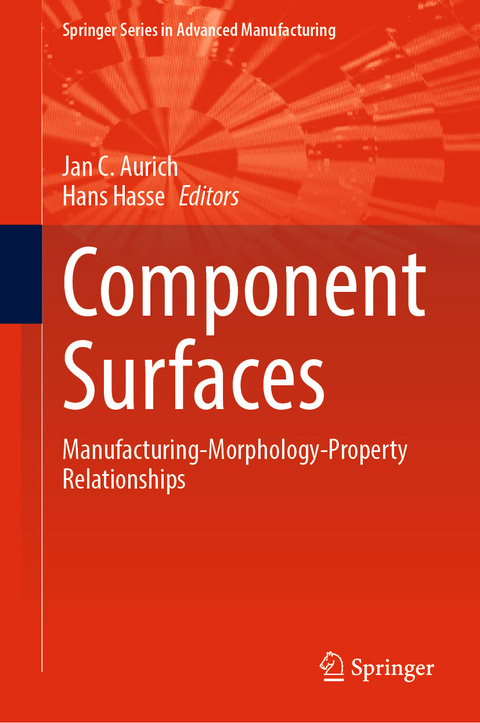
Component Surfaces
Springer International Publishing (Verlag)
978-3-031-35574-5 (ISBN)
This book sheds new light on component surfaces and the scientific fundamentals of their creation, characterization, and application. The book also provides a new interdisciplinary perspective on the topic, studying component surfaces with a multiscale approach and linking fundamental and applied research. The book builds on the success of the coordinated research project funded by Deutsche Forschungsgemeinschaft (DFG) from 2011 - 2023: the CollaborativeResearch Center CRC 926 "Microscale Morphology of Component Surfaces (MI-COS)", in which, over the years, 100+ researchers have co-operated at the University of Kaiserslautern, Germany, and affiliated institutes, yielding 500+ scientific papers in journals from different fields of science and engineering.
Divided into 2 main parts, the book starts with an introduction to the concept of Manufacturing-Morphology-Property (MMP) Relationships and dives into the fundamentals and technologies, including topics such as the geometrical, microstructural, and chemical characterization, indentation, and scratching on the nanoscale, micro milling and micro grinding, cryogenic machining, cold spraying, and additive manufacturing. In the first part, readers discover more about the interactions between particles and surfaces, the interrelationship of manufacturing, surface morphology and properties of titanium, the influence of manufacturing and load conditions on the phase transformation and fatigue of austenitic stainless steels, and the influence of surface morphology on fatigue and tribological behavior of Transformation-Induced-Plasticity (TRIP)/Twinning-Induced Plasticity (TWIP) Steels. The second part of this book is devoted to the applications of component surfaces, covering topics like the manufacturing of areal material measures, MMP relationships for rotating shaft sealing systems, the influence of the surface morphology on rolling bearing life under mixed lubrication, MMP relationships for chain joints, and MMP for biofilms.
Scientists and engineers who deal with the influence of surfaces on macroscopic properties of components and who are interested in designing and manufacturing these surfaces to obtain desired component properties will understand the appeal of this work. Given its interdisciplinary breadth, the book also appeals to scholars and professionals in the fields of mechanical engineering, process engineering, and physics.
lt;p>Hans Hasse is Professor in the Department of Mechanical and Process Engineering at the University of Kaiserslautern, Germany, and Director of the Laboratory of Engineering Thermodynamics since 2008. He holds a Ph.D. in Chemical Thermodynamics from the same university and worked afterward as Process Engineer at BASF and as Director of the Institute of Thermodynamics and Thermal Process Engineering at the University of Stuttgart. His research interests are focused on molecular thermodynamics, process thermodynamics, and biothermodynamics, and he published 400+ articles published and 40+ patents in these fields. He currently serves as Vice President of the German Research Foundation (DFG).
Jan Aurich is Professor in the Department of Mechanical and Process Engineering at the University of Kaiserslautern, Germany, and Chair of manufacturing technology and production systems. His research focuses on additive manufacturing, micromachining, coating, and cyber-physical production systems, in which he has published 200+ articles and has 2 patents. He is also Member of the German Academic Society for Production Engineering (WGP) and Member of the Evaluation Committee of the German Science and Humanities Council (WR).
Chapter 1. Manufacturing-Morphology-Property (MMP) Relationships: Concept and Application to Component Surfaces.- Part I. Fundamentals and Technologies.- Chapter 2. Geometrical, Microstructural, and Chemical Characterization.- Chapter 3. Indentation and Scratching on the Nanoscale.- Chapter 4. Creating Surface Morphologies by Micro Milling and Micro Grinding.- Chapter 5. Creating Surface Morphologies by Cryogenic Machining.- Chapter 6. Creating Surface Morphologies by Cold Spraying.- Chapter 7. Creating Surface Morphologies by Additive Manufacturing.- Chapter 8. Interactions Between Particles and Surfaces.- Chapter 9. Adsorption and Wetting of Component Surfaces.- Chapter 10. Interrelationship of Manufacturing, Surface Morphology, and Properties of Titanium.- Chapter 11. Influence of Manufacturing and Load Conditions on the Phase Transformation and Fatigue of Austenitic Stainless Steels.- Chapter12. Influence of Surface Morphology on Fatigue and Tribological Behavior of TRIP/TWIP Steels.- Part II. Applications.- Chapter 13. Manufacturing of Areal Material Measures.- Chapter 14. Manufacturing-Morphology-Property Relationships for Rotating Shaft Sealing Systems.- Chapter 15. Influence of the Surface Morphology on Rolling Bearing Life under Mixed Lubrication.- Chapter 16. Manufacturing-Morphology-Property Relationships for Chain Joints.- Chapter 17. Manufacturing-Morphology-Property Relationships for Biofilms.
| Erscheinungsdatum | 03.09.2023 |
|---|---|
| Reihe/Serie | Springer Series in Advanced Manufacturing |
| Zusatzinfo | XIV, 442 p. 290 illus., 235 illus. in color. |
| Verlagsort | Cham |
| Sprache | englisch |
| Maße | 155 x 235 mm |
| Gewicht | 883 g |
| Themenwelt | Technik ► Maschinenbau |
| Schlagworte | Additive Manufacturing • Application of component surfaces • Biofilms • Cold-spraying • cryogenic machining • fatigue properties • Manufacturing-Morphology-property Relationship • Mechanical Component Surfaces • Micro-Grinding • micro-milling • Microscale surface morphology • Surface characterization • surface modification • Ti-6Al-4V • Tribological behaviour |
| ISBN-10 | 3-031-35574-1 / 3031355741 |
| ISBN-13 | 978-3-031-35574-5 / 9783031355745 |
| Zustand | Neuware |
| Informationen gemäß Produktsicherheitsverordnung (GPSR) | |
| Haben Sie eine Frage zum Produkt? |
aus dem Bereich


